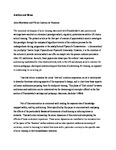Auditions and stress
| dc.contributor.author | Matthews, J | |
| dc.contributor.author | Ladron de Guevara, V | |
| dc.date.accessioned | 2017-12-15T14:25:33Z | |
| dc.date.available | 2017-12-15T14:25:33Z | |
| dc.date.issued | 2017-09-27 | |
| dc.identifier.issn | 2056-7790 | |
| dc.identifier.issn | 2054-4170 | |
| dc.identifier.uri | http://hdl.handle.net/10026.1/10433 | |
| dc.description | peerreview_statement: The publishing and review policy for this title is described in its Aims & Scope. aims_and_scope_url: http://www.tandfonline.com/action/journalInformation?show=aimsScope&journalCode=rfst20 | |
| dc.description.abstract |
This is the beginning of a four-part series of interrelated articles discussing the pedagogical, ideological, and sociological functions of the audition process in drama school training. This first article considers the initial “first call” audition experience, foregrounding the stress-inducing aspects of the experience’s design, and charting how these aspects influence auditionees. It is the premise of this article that stress cannot be understood merely as negative and, instead, may be a sign of a transformative experience that can be equated to a rite of passage. In here, we recognize that the canonical techniques of actor training associated with Stanislavski’s work have resulted in a dominant paradigm which, arguably, predominates within UK drama school training. Consequently, the present article uses key segments of the first section of Stanislavski’s An Actor’s Work to offer a number of readings about the phase of “first contact” between auditionee and institution. Taking its cue from the analysis of significant events of the audition process for the undergraduate acting programme at the newly formed Plymouth Conservatoire–a drama school run jointly by Theatre Royal Plymouth and Plymouth University–the first article in the series investigates that dominant paradigm. Yet, aiming to offer an insight into the generic audition process in other HE institutions, all papers in this series will draw upon the authors’ own experience auditioning candidates for Plymouth Conservatoire, and for other drama schools, both in the UK and abroad, so as to uncover the various pedagogic, ideological, and sociological functions of auditioning for training. | |
| dc.format.extent | 217-231 | |
| dc.language | en | |
| dc.language.iso | en | |
| dc.publisher | Informa UK Limited | |
| dc.subject | Audition | |
| dc.subject | stress | |
| dc.subject | Rites de Passage | |
| dc.subject | institutional expectations | |
| dc.subject | artistic/professional judgements | |
| dc.title | Auditions and stress | |
| dc.type | journal-article | |
| dc.type | Article | |
| plymouth.issue | 2 | |
| plymouth.volume | 5 | |
| plymouth.publication-status | Published | |
| plymouth.journal | Stanislavski Studies | |
| dc.identifier.doi | 10.1080/20567790.2017.1377931 | |
| plymouth.organisational-group | /Plymouth | |
| plymouth.organisational-group | /Plymouth/Faculty of Arts, Humanities and Business | |
| plymouth.organisational-group | /Plymouth/Faculty of Arts, Humanities and Business/School of Society and Culture | |
| plymouth.organisational-group | /Plymouth/REF 2021 Researchers by UoA | |
| plymouth.organisational-group | /Plymouth/REF 2021 Researchers by UoA/UoA33 Music, Drama, Dance, Performing Arts, Film and Screen Studies | |
| plymouth.organisational-group | /Plymouth/Users by role | |
| plymouth.organisational-group | /Plymouth/Users by role/Academics | |
| dcterms.dateAccepted | 2017-09-08 | |
| dc.rights.embargodate | 2019-3-27 | |
| dc.identifier.eissn | 2054-4170 | |
| dc.rights.embargoperiod | Not known | |
| rioxxterms.versionofrecord | 10.1080/20567790.2017.1377931 | |
| rioxxterms.licenseref.uri | http://www.rioxx.net/licenses/all-rights-reserved | |
| rioxxterms.licenseref.startdate | 2017-09-27 | |
| rioxxterms.type | Journal Article/Review | |
| plymouth.funder | Anatomy of Performance Training::AHRC |


